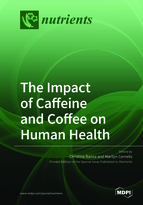The Impact of Caffeine and Coffee on Human Health
A special issue of Nutrients (ISSN 2072-6643).
Deadline for manuscript submissions: closed (20 August 2018) | Viewed by 240601
Special Issue Editors
Interests: health effects of diet and dietary patterns; epidemiological studies of the association of lifestyle factors with health outcomes; interactions between dietary components in relation to health outcomes; coffee intake in relation to cancer incidence/mortality
Interests: caffeine; coffee; taste; diet behaviours; precison nutrition; genetics; omics; cardiometabolic traits; dementia; aging
Special Issues, Collections and Topics in MDPI journals
Special Issue Information
Dear Colleagues,
We invite you to contribute to a Special Issue of Nutrients, entitled “The Impact of Caffeine and Coffee on Human Health”. The purpose of this Special Issue is to provide a thorough and up-to-date presentation of research investigating the impact of coffee and/or caffeine intake on various health outcomes.
We welcome the submission of original research articles and/or systematic Reviews/meta-analyses focusing on several aspects of coffee/caffeine intake in relation to human health. Areas of interest include, but are not limited to, the following topics:
- Human clinical trials of coffee or caffeine use in relation to disease or intermediate phenotypes.
- Epidemiological studies of habitual coffee or caffeine intake in relation to human health, among the general public, as well as, among special populations (i.e., children, pregnant women, diabetics, cancer patients, hypertensives, etc.)
- Mechanisms of action of nutrients and other bioactive components of coffee/caffeine.
- Studies integrating genetic or physiological markers of coffee/caffeine intake to investigations of coffee and health.
Assist. Prof. Dr. Marilyn Cornelis
Guest Editors
Manuscript Submission Information
Manuscripts should be submitted online at www.mdpi.com by registering and logging in to this website. Once you are registered, click here to go to the submission form. Manuscripts can be submitted until the deadline. All submissions that pass pre-check are peer-reviewed. Accepted papers will be published continuously in the journal (as soon as accepted) and will be listed together on the special issue website. Research articles, review articles as well as short communications are invited. For planned papers, a title and short abstract (about 100 words) can be sent to the Editorial Office for announcement on this website.
Submitted manuscripts should not have been published previously, nor be under consideration for publication elsewhere (except conference proceedings papers). All manuscripts are thoroughly refereed through a single-blind peer-review process. A guide for authors and other relevant information for submission of manuscripts is available on the Instructions for Authors page. Nutrients is an international peer-reviewed open access semimonthly journal published by MDPI.
Please visit the Instructions for Authors page before submitting a manuscript. The Article Processing Charge (APC) for publication in this open access journal is 2900 CHF (Swiss Francs). Submitted papers should be well formatted and use good English. Authors may use MDPI's English editing service prior to publication or during author revisions.
Keywords
- coffee
- caffeine
- health
- biomarker
- epidemiology
- clinical trial
- genetics








